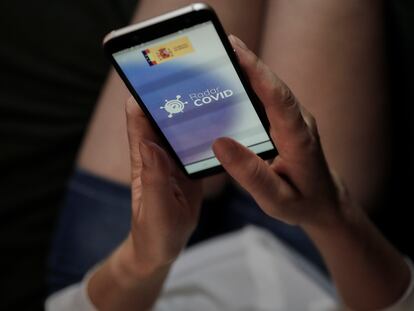Major coronavirus study in Spanish summer camps shows low transmission among children
The research project, which tracked 1,900 youngsters and monitors in Barcelona, found contagion rates that were up to six times lower than those among the general population

Children and adolescents who took part in 22 summer camps in the Barcelona area in recent months have been found to have a capacity to transmit the coronavirus that is up to six times lower than that of the general population.
That is the preliminary conclusion of the biggest study so far carried out about the transmission dynamics of SARS-CoV-2 among minors. The research was carried out by a team from the Sant Joan de Déu children’s hospital in the Catalan capital. The authors of the study chose summer camps on the basis that they are “environments that are comparable with, or similar to, those of schools.”
There are, however, differences, the researchers pointed out. The most important of these is that practically all of the summer camps’ activities are usually carried out in the open air, unlike regular school classes, and the groups were limited to a maximum of 10 children, rather than the class sizes of 20 that have been established for the upcoming school year.
For five weeks, the study tracked “more than 1,900 people, including children and monitors, at 22 summer schools in the Barcelona area, in an urban environment,” explained Juanjo García, the head of pediatrics at the hospital. “Every week a group of hospital personnel would travel to the camp and take saliva samples for a PCR test,” he added. This type of screening was one of the novelties of the study, given that it is usually done via a nasal swab.
Another significant discovery is that “children under the age of 12 have the same transmission capacity as those aged 13 to 17”
“For the five weeks that the investigation lasted, we were able to detect 39 newly appeared index cases,” of which 30 were found in children, Iolanda Jordan, the head researcher, explained. “These children had 253 contacts, who were boys and girls from their respective cohabitation groups. From these, there were only 12 contagions, which is 4.7% and an R reproduction rate of 0.3. This is a low R number, six times lower than the one that we have found among the general population, which ranges from 1.7 to 2,” Jordan added, in reference to the same neighborhoods in which the summer camps were taking place.
Another significant discovery, Jordan continued, is that “children under the age of 12 have the same transmission capacity as those aged 13 to 17.”
If we do things with a series of strategies, the impact of opening schools will probably be lowHead researcher Iolanda Jordan
The authors of the study pointed out that they discovered a “direct correlation between the incidence in the general population and the index cases that we found in the summer schools” that were held in the same areas. “This leads us to think that the role of the summer schools [in the transmission of the virus] was really low,” they explained.
“These data give us some clues ahead of the reopening of schools,” Jordan explained. “If we do things with a series of strategies, the impact of opening schools will probably be low [on the general incidence of the virus] and we will be able to open them safely and with transmission rates that are as low as possible,” she added.
The most important of these strategies are the so-called “bubbles” – where classes do not mix and children do not do activities with students outside of these groups – and hand-washing. In the former case, these closed groups not only “have helped to keep these transmission rates low,” but also, once a case has been detected, have facilitated the “tracing of contacts” and establishing “more selective quarantines.”
As for hand-washing, Jordan pointed to the fact that “in the schools where this washing of hands was carried out on a more frequent basis, and specifically more than five times a day, the infection rates were null or very low, and as such this is a very important measure to be taken into account.”
Kids Corona
Manel de Castillo, the director of the Sant Joan de Déu Hospital, said that “the study is probably the most important one on an international level, which has mobilized more than 60 people during these months.” He also underlined “the efforts that have been made” to come up with these preliminary results ahead of the start of the school year in Spain in order to provide evidence related to the challenge posed by the reopening of classrooms.
The results of this investigation, he added, have already been presented to the World Health Organization (WHO) and the European Center for Disease Prevention and Control (ECDC).
The study forms part of the Kids Corona platform, which, for several months, has been trying to shed light on the impact that the coronavirus pandemic is having on the child population and the role that this age group has on the dynamics of coronavirus transmission. “In June, we saw the results of the first home study, where we saw that in families where the father or the mother had had Covid, children got infected in similar proportions as the adults,” Del Castillo explained, although the infections in these cases were much milder.
English version by Simon Hunter.
Tu suscripción se está usando en otro dispositivo
¿Quieres añadir otro usuario a tu suscripción?
Si continúas leyendo en este dispositivo, no se podrá leer en el otro.
FlechaTu suscripción se está usando en otro dispositivo y solo puedes acceder a EL PAÍS desde un dispositivo a la vez.
Si quieres compartir tu cuenta, cambia tu suscripción a la modalidad Premium, así podrás añadir otro usuario. Cada uno accederá con su propia cuenta de email, lo que os permitirá personalizar vuestra experiencia en EL PAÍS.
En el caso de no saber quién está usando tu cuenta, te recomendamos cambiar tu contraseña aquí.
Si decides continuar compartiendo tu cuenta, este mensaje se mostrará en tu dispositivo y en el de la otra persona que está usando tu cuenta de forma indefinida, afectando a tu experiencia de lectura. Puedes consultar aquí los términos y condiciones de la suscripción digital.









































